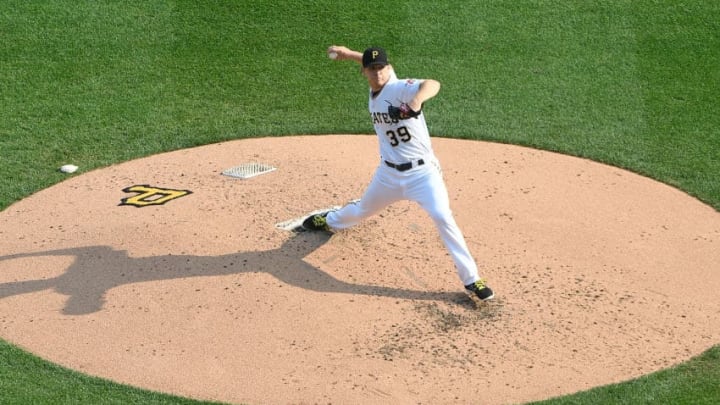Analysis: Chad Kuhl had an up and down rookie season in 2016, at times showing solid back of the rotation stuff, but the inconsistencies also made him look like a bullpen candidate. More of the same occurred in his second season, though he did add a curveball to his pitch selection.
In 2016, Chad Kuhl made his debut against Clayton Kershaw, and he had mixed results. He only lasted five innings, and he allowed three runs with four walks, but he did strike out five and top out at 96.8 miles per hour. That basically sums up Chad Kuhl, a hard throwing right-handed pitcher who has had control problems.
Kuhl’s 2016 season saw him post a 103 ERA- and a 97 FIP-, making him essentially league average. His DRA, on the other hand, was much worse with a mark of 4.85 and a DRA- of 107.4. There were concerns with Kuhl, as Steamer projected him for a 4.48 ERA and 4.29 FIP, ZiPS projected 4.51 and 4.52, and PECOTA – Baseball Prospectus’ projection system, had Kuhl with a 4.23 ERA and 4.59 DRA.
His actual numbers were near those projections, a 4.35 ERA, and 4.24 FIP – though his DRA was 5.24 (111.5 DRA-) – and they’re fine numbers for a backend starter or bullpen arm. He improved as the year went on, and was much better in the second half in the first half in the ERA department, though his FIP remained pretty much constant. The big thing for Kuhl is his ERA finally starting to normalize after under pitching his FIP (you can scroll through the starts by swiping right or left on the Tableau):
The drop in ERA, and really the start of a trend for him really preventing more runs and getting closer and closer toward his FIP, is May 26, the start before he added his curveball. Before that start, he was mainly a sinker, change up, and slider pitcher. But perhaps that curveball is the difference for Kuhl. Here’s the breakdown of each month and the usage of the pitch:
Months | FF% | SI% | CH% | SL% | CV% |
| 2016 | |||||
| June | 0.00% | 74.07% | 2.47% | 23.46% | 0.00% |
| July | 0.00% | 60.87% | 11.30% | 27.83% | 0.00% |
| August | 0.00% | 60.95% | 10.84% | 28.22% | 0.00% |
| September/October | 0.00% | 59.64% | 8.85% | 31.51% | 0.00% |
| 2017 | |||||
| April | 0.00% | 65.69% | 8.78% | 25.53% | 0.00% |
| May | 0.00% | 62.66% | 15.61% | 18.35% | 3.38% |
| June | 0.00% | 57.06% | 7.76% | 29.09% | 6.09% |
| July | 0.00% | 69.79% | 8.82% | 14.45% | 6.94% |
| August | 0.72% | 64.50% | 9.37% | 15.86% | 9.55% |
| September/October | 0.54% | 56.18% | 7.26% | 25.27% | 10.75% |
He increased his curveball percentage each month as he got more comfortable with it. From May 31, the first game where Kuhl used the curve, he posted an ERA- of 84 and a strikeout rate of 22.2 percent in 113 innings. In his first 115 innings, Chad Kuhl had an ERA- of 120 and a strikeout rate of 17.7 percent. Though, in both periods his FIP- was 99, so after underperforming his FIP, he overperformed and started to converge to his FIP.
Though even with the newfound pitch, Kuhl’s control became more of a problem, as in everything, there has to be a tradeoff. In the first 115 innings, Kuhl had a walk rate of 7.4 percent and a zone percent of 49.8 percent. In his next 113 innings after finding the curve, those numbers are 11.5 percent and 47.5 percent respectively. Over the last two years, the league average has been an 8.4 percent walk rate and somewhere between 46-47 percent zone rate. Just like the run rates above, here is a Tableau of Kuhl’s strikeout and walk rates, along with his unintentional walks+hit by pitch rate:
Chad Kuhl has good stuff, his fastball ranks 11th fastest among pitchers who threw 1000 or more and his slider ranked 16th in run value among pitchers with 140 or more innings. One of the biggest issues for Kuhl is his changeup. In 2017, among pitchers with 140 or more innings, Kuhl’s change had the worst run value. It’s a pitch Kuhl relied on early on in his career, throwing it 10.78 percent of the time before May 31, but after just 8.70 percent, similar to the curve rate of 8.75 percent. Against left-handed hitters, he went from using the pitch 17.97 percent of the time to 13.77 percent of the time, though the slugging against went from .614 to .792. It’s a pitch he should probably drop from his arsenal, and go with two breaking balls instead.
In fact, it is the changeup that makes it seem like he is best suited for the bullpen, and the power fastball with power slider makes him an interesting candidate to be a Chad Green type, who has become a relief weapon for the New York Yankees. Green, who pitched multiple innings in 29 of his 39 relief outings, allowed the Yankees deepen their bullpen. Chad Kuhl can pitch two innings out of the pen twice a week, and create a real weapon for the club. On the other hand, Kuhl has been league average as a starter in 2016 and 2017, and that provides real value, especially given his run rates since throwing the curveball. This creates an interesting pitcher entering his third season, and one in which his future role might be more clear.
*Numbers from baseball-reference, FanGraphs, baseball prospectus, and brooks baseball
